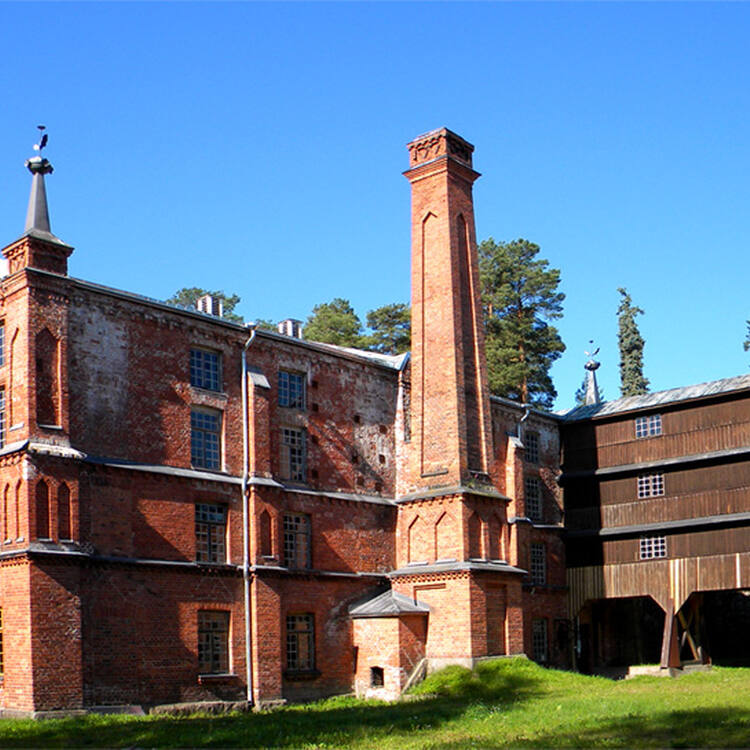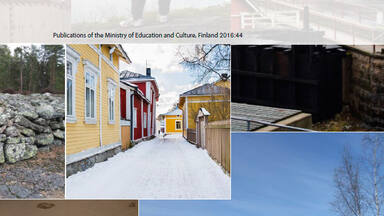Verla Groundwood and Board Mill
Verla Groundwood and Board Mill
The Verla groundwood and board mill and its associated residential area is an outstanding, remarkably well-preserved example of the small-scale rural industrial settlements associated with pulp, paper and board production that flourished in northern Europe and North America in the 19th and early 20th centuries. Only a handful of such settlements survive to the present day.
Description is available under license CC-BY-SA IGO 3.0
Usine de traitement du bois et de carton de Verla
L’usine de bois de Verla et le secteur résidentiel associé sont un exemple exceptionnel et remarquablement bien conservé d’installation industrielle rurale de petite dimension consacrée à la fabrication de pâte à papier, de papier et de carton. Ce type d’installation qui prospéra en Europe du Nord et en Amérique du Nord au XIXe et au début du XXe siècle a presque totalement disparu aujourd’hui.
Description is available under license CC-BY-SA IGO 3.0
معمل فرلا لمعالجة الخشب والكرتون
يشكّل كل من معمل فرلا للخشب ومن القطاع السكني المرتبط به نموذجاً استثنائياً تمّ الحفاظ عليه بطريقة مذهلة للإنشاءات الصناعية الريفية ذات الحجم الصغير المختصة بصناعة الورق المقوَّى والورق والكرتون. إنّ هذا النوع من الإنشاءات الذي ازدهر في شمال أوروبا وأميركا الشمالية في القرن التاسع عشر وفي مطلع القرن العشرين قد زال اليوم بصورة شبه كلية.
source: UNESCO/CPE
Description is available under license CC-BY-SA IGO 3.0
韦尔拉磨木纸板厂
韦尔拉磨木纸板厂与其周边的居民住宅区一起构成了一个保存完好的农村小型工业基地范例,这种生产纸浆、纸张和纸板的小工业作坊在19世纪至20世纪初的欧洲和北美非常盛行,但只有很少一部分住区保留至今。
source: UNESCO/CPE
Description is available under license CC-BY-SA IGO 3.0
Деревоперерабатывающая фабрика в Верле
Деревоперерабатывающая фабрика в Верле и примыкающий к ней жилой район – это выдающийся и очень хорошо сохранившийся пример небольшого промышленного поселения в сельской местности. Производство древесной массы, целлюлозы, бумаги и досок процветало в Северной Европе и Северной Америке в XIX - начале XX вв. Только немногие из таких поселений сохранились до наших дней.
source: UNESCO/CPE
Description is available under license CC-BY-SA IGO 3.0
Fábrica de tratamiento de madera y cartón de Verla
Admirablemente bien conservadas, la fábrica de Verla y el área de viviendas conexa constituyen un ejemplo excepcional de instalación industrial rural de pequeñas dimensiones dedicada a la producción de pasta de papel, papel y cartón. Las manufacturas de este tipo proliferaron en Europa Septentrional y América del Norte durante el siglo XIX y comienzos del siglo XX, pero hoy en día han desaparecido casi por completo.
source: UNESCO/CPE
Description is available under license CC-BY-SA IGO 3.0
ヴェルラ砕木・板紙工場
1882~1964年まで稼働していた工場群。19世紀後半からスカンディナヴィア半島やロシア北部の松林の各所で見られた同様な工場施設のなかで、今に至るまで残された最後の、そして最良の例を示す一つである。source: NFUAJ
Hout- en kartonfabriek van Verla
De hout- en kartonfabriek van Verla en de bijbehorende woonwijk is een bijzonder en goed bewaard gebleven voorbeeld van kleinschalige landelijke industriële nederzettingen gelieerd aan pulp, papier en kartonproductie. In de 19e en het begin van de 20e eeuw bloeide deze industrie overal op in Noord-Europa en Noord-Amerika. Er zijn slechts een handjevol van dit soort nederzettingen bewaard gebleven. De eerste houtmolen werd in 1872 gebouwd op de westelijke oever van de stroomversnelling Verlankoski, maar moest sluiten vanwege financiële problemen en een brand in 1876. Een nieuwe, grotere molen werd in 1882 gebouwd, met een aangrenzende kartonfabriek.
Source: unesco.nl
Outstanding Universal Value
Brief synthesis
Verla Groundwood and Board Mill, located in the northern part of the Kymi River Valley in southeast Finland, consists of the Mill, the associated residential area and the power plants. The mill buildings and the workers' houses mostly date from the 1890s and from the beginning of the 20th century. The property is a very well preserved example of a forest industry settlement of the late 19th century. Similar communities were established in coniferous forest zones in northern Europe and in North America, where wood as a raw material and water as a source of energy were easily at hand.
The first groundwood mill in Verla was founded in 1872 and the board mill began operations ten years later. The existing buildings, which are architecturally harmonious, date back to the turn of the 20th century. The mill itself ceased to operate in 1964, and all the machines and items related to production were left in the mill as they were when the production ceased. The buildings and the machines were carefully conserved and turned into a museum, and the Verla Mill Museum was officially opened in 1972.
The property itself consists of approximately 50 buildings in an area of 23 ha. The Verlankoski Rapids separate the production area from the residential area. On the rapids, there are three water power plants from three different decades, the newest one dating from the 1990s. The mill owner’s residence and a park from the late 19th century dominate the village. The sheer rock face above the rapids bears a prehistoric rock painting, representing fishing and hunting.
Criterion (iv): The Verla Groundwood and Board Mill and its associated habitation are an outstanding and remarkably well preserved example of the small-scale rural industrial settlement associated with pulp, paper, and board production that flourished in northern Europe and North America in the 19th and early 20th centuries, of which only a handful survives to the present day.
Integrity
The Verla Groundwood and Board Mill with its machinery, the Verlankoski Rapids and power plants, the associated residential area and installations form a visually and functionally intact complex. The property includes all the built elements associated with production, habitation and leisure in the mill village, as well as the rapids, the surrounding forests, and the prehistoric rock painting.
Authenticity
The Verla Groundwood and Board Mill and its associated buildings, equipment, installations and landscape have remained almost intact. The fact that the machinery needed for the production of groundwood pulp and board has remained at its original place adds to the authenticity. The buildings and the installations have preserved their characteristic features with regard to the materials, construction methods and architecture. Furthermore, the authenticity of Verla is reinforced by the well-preserved wooded landscape.
Protection and management requirements
Verla is protected according to national legislation. UPM-Kymmene Corporation, the principal landowner, is responsible for the administration of the site and for the Management Board of Verla, which includes the authorities and owners of the site. The Board controls and instructs the operations involving restoration and maintenance according to the Management Plan.
The groundwood and board mill is surrounded by a forested area, which is located in the buffer zone of the property. Landscape and environment values are taken into consideration when forestry work is done.
The flow of water in the power plant canal, adjacent to the board mill, has threatened the conservation and safety of the mill building, as water from the canal was leaking into the mill. To solve this problem, a new power plant canal, which separates the water from the building, was opened in January 2014.
Verla Groundwood and Board Mill is located in a rural area and is closed during the winter. Due to its remote location, fire and other accidents are considered potential threats to the property. Because of this, the most central parts of the property are protected by automatic fire alarms and fire extinguishing systems.


